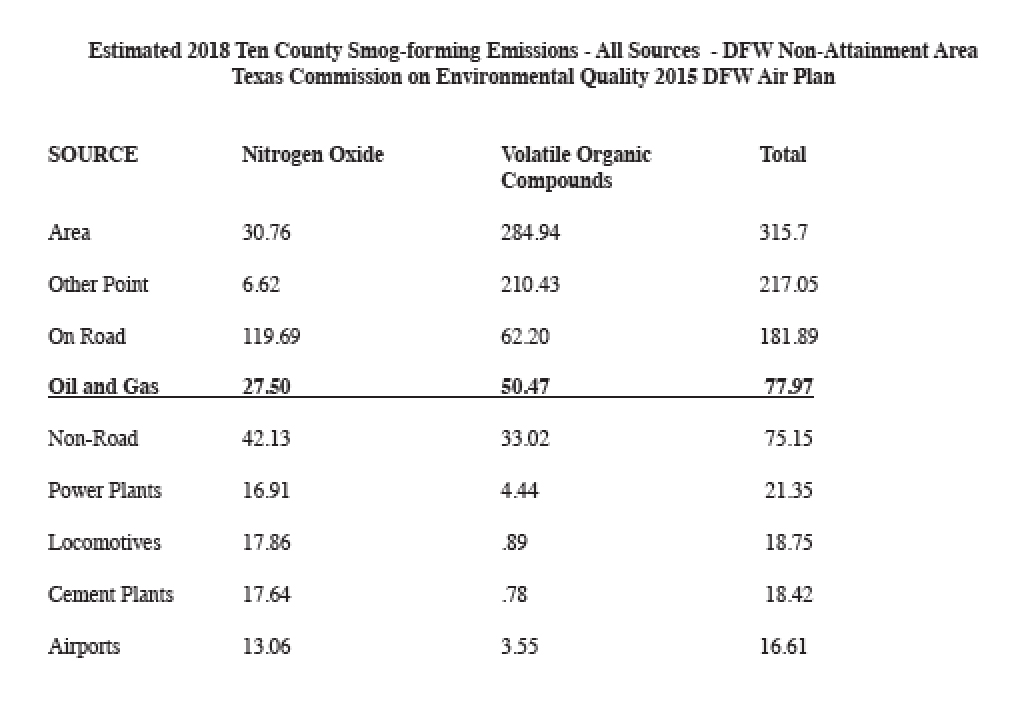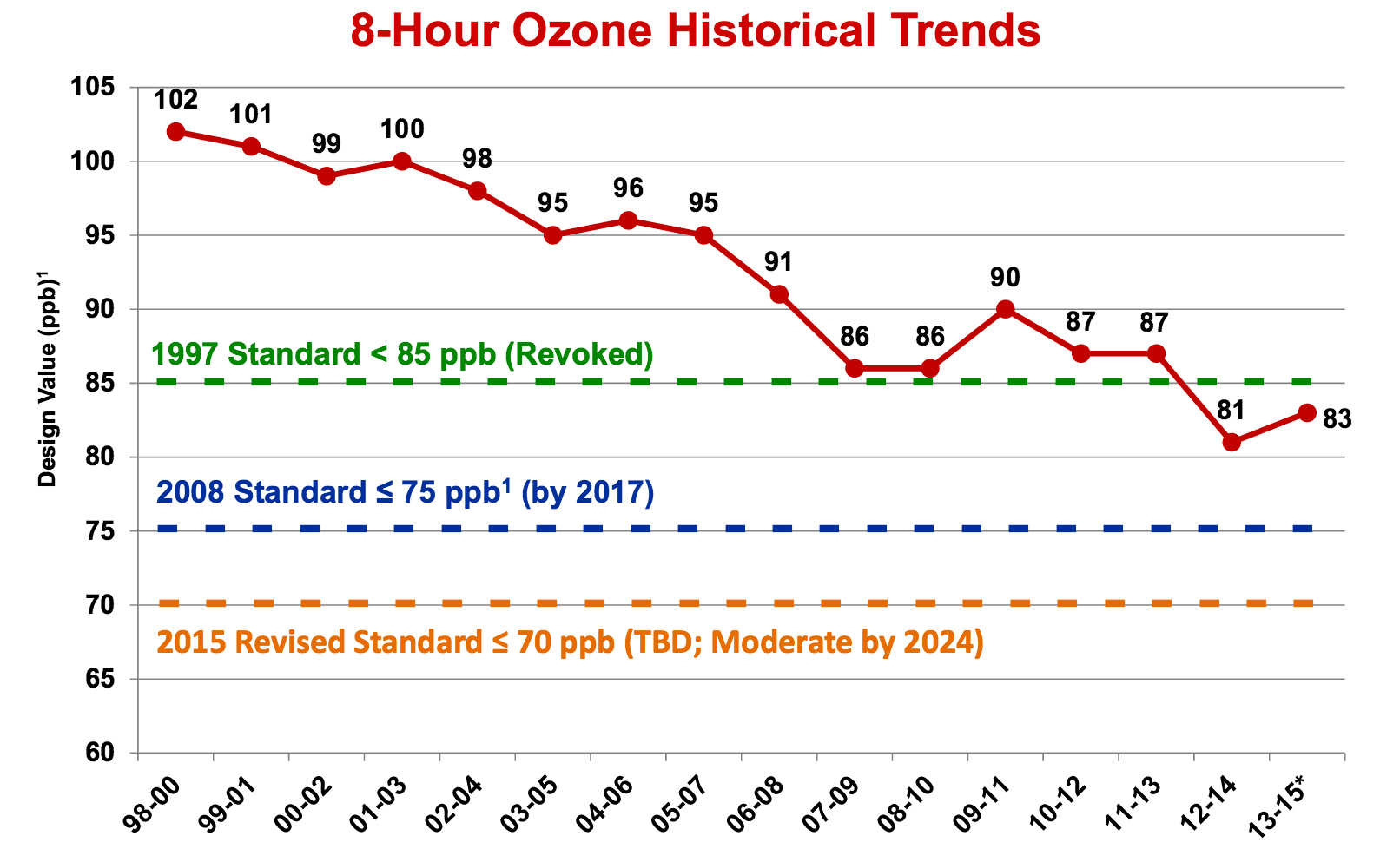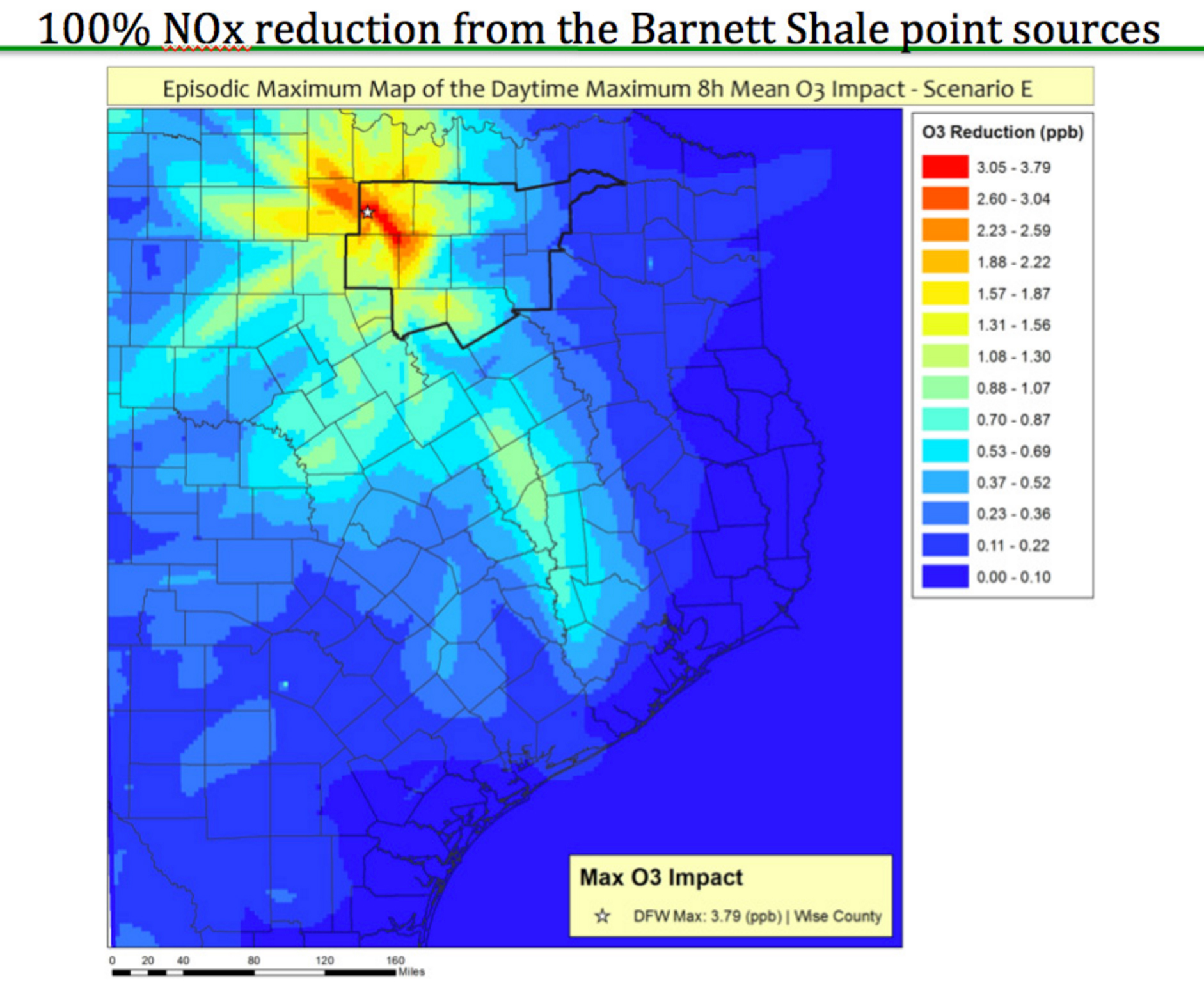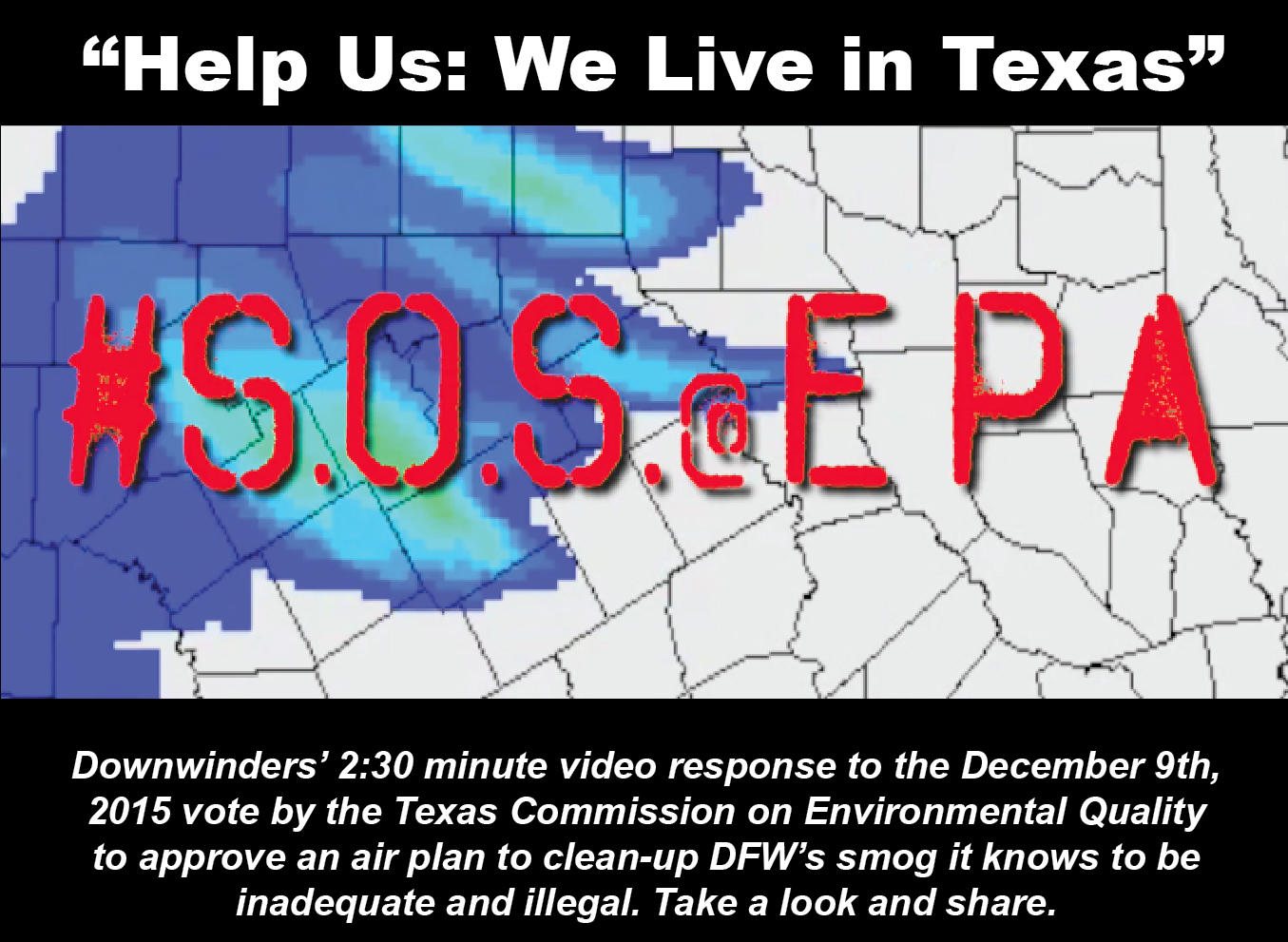The Fastest Way to Get Big Cuts in Fracking Pollution? A Good DFW Smog Plan.
Public Hearing on DFW Air
Thursday, January 21st
6:30
616 Six Flags Road in Arlington
(Map)
If you're fighting fracking in your North Texas community, you have few options these days. The State of Texas is not only very not interested in hearing about fracking problems, it just passed a law that makes it illegal for your city to be too interested in hearing from you about those problems as well.
Enter another DFW anti-smog plan. In the past, these plans have been written by Austin and have tired their best to ignore the large volumes of smog-forming pollution from oil and gas sources. This new plan is no different. Left up to the State, there would be no new cuts in pollution from any major industrial source, including the gas industry.
But EPA may not leave it up to the state this time. There are already indications the EPA will reject the State's air plan for DFW as being inadequate and draft one of its own. That would be good news for local anti-fracking activists. Why? Because it could mean cutting lots and lots of different kinds Barnett Shale pollution throughout the region and help shift the costs of its harmful impacts to industry.
That's why if you're concerned about fracking, you owe to yourself to show-up at this Thursday's public hearing and tell the EPA you want them to reject the state's do-nothing air plan and instead implement a "Federal Implementation Plan" to clean up DFW's chronically smoggy air.
The Case For Cutting Oil and Gas Pollution in a DFW Anti-Smog Plan
1. The Oil and Gas Industry is a Large Source of Smog Pollution in North Texas
Look at the chart below for where and in what volumes the State believes smog-forming pollution will be coming from in 2017. The numbers are directly from the Texas Commission on Environmental Quality's DFW air plan. It's in TONS PER DAY.

Oil and Gas pollution is the fourth largest category of smog pollution in North Texas. It's the fourth largest category for Nitrogen Oxide (NOx) pollution – the kind the State believes is most responsible for DFW smog. It's also the fourth largest source for Volatile Organic Compounds (VOCs), another kind of smog pollution that many of us believe plays a bigger role than the State thinks.
And these are the State's own numbers so you can be sure they're underestimates.
For example, a recent review of studies estimated that the Barnett Shale gas production was leaking up to twice as much climate-damaging methane as the EPA predicts. Methane doesn't escape by itself. If it's leaking, so are smog-forming VOCs that come up with the Methane.
Bottom Line: a huge new category of smog pollution has been created in DFW in just the last 8 years.
2. Oil and Gas Air Pollution is making DFW Smog Worse
Even the State admits that pollution from Barnett Shale industry sources contributes to DFW smog, the only disagreement is by how much.

Take a look at another chart – one that tracks the "average regional" smog level over the decades. Notice the downward trend that stops around 2009, where it continues to hover around 85 ppb? Can you think of anything that began happening in DFW in a big way around 2008-9 that would have stopped that downward trend?
Part of the problem is location. Historically, DFW's worst-performing air monitors, the places where the air quality always seems to be worse at the end of every "ozone action day" are located in the Northwest part of the Metromess – Keller, Grapevine, Denton, and Eagle Mountain Lake. Predominant winds are from the southeast to the northwest in summer time, pushing all of DFW's pollution toward Denton and Wise Counties.
Imagine what happens when you begin to envelope those same northwest areas into the country's largest urban gas field. In 2011, the State estimated that there was more VOC pollution coming from O&G sources in the region than from all the cars and trucks on the road in North Texas at the time.
This impact has not escaped EPA's notice. In official comments filed last February the Agency wrote that those Northwest monitors have not seen their ozone numbers come down as much as other parts of the region and suggest the sea of O&G pollution surrounding them may be the reason.
Thanks to the landmark UNT study that cloned the State's own computer air model for the DFW plan, we know exactly what kind of influence O&G pollution has on those monitors – or at least what the impacts are using the State's underestimated numbers.
If you took away all the estimated 2017 pollution from the Barnett Shale in DFW, you'd see drops in ozone of…
5.4 ppb at the Eagle Mountain Lake air monitor site
5.3 ppb in Keller
4.9 in NW Ft. Worth
3.6 ppb in Denton
These reductions in ozone would be enough to bring all of these DFW air monitor sites into compliance with the current 75 ppb standard, and allow all the sites except Denton to reach the new 70 ppb federal ozone standard more quickly than the deadline of 2025.
Conversely – you can see these numbers as the added smoggy burden the industry is imposing on DFW now. According to the State itself, O&G pollution are raising ozone levels as much as 3 to 5 ppb across large parts of the region.
3. Large Cuts in O&G Pollution = Less Smog in DFW
If oil and gas pollution is a large source of smog pollution, it makes sense that cutting that pollution would lead to less smog. Because of the UNT report, we know how much regional smog would decrease if we took some steps to stop down O&G pollution.
For example, just converting all 647 large gas compressors (point sources) in North Texas from diesel or gas to electricity – something the industry says it can do in areas with air pollution problems – would take over 16 tons of NOx pollution out of the air each and every day and lead to a drop of over 3 ppb at the Eagle Mountain Lake site and between 1 and over 2 ppb at 10 other air monitor sites. That may not sound like much, but it's enough to send most of them into compliance with the current 75 ppb standard. And that's not even accounting for the decrease in Particulate Matter pollution that would accompany such a transition. Because compressors are the industry's largest source of Nitrogen Oxides, they should be a big target for a new EPA air plan for DFW.
 VOC pollution could also decrease under an EPA plan. Under the EPA's proposed new methane rules, there are a series of guidelines for controlling the pollutant that would also end-up cutting other smog-forming and toxic VOC pollution as a side-benefit. We're talking Benzene and all the other nasties the human eye can't see coming out of a storage tank or dehydrator.
VOC pollution could also decrease under an EPA plan. Under the EPA's proposed new methane rules, there are a series of guidelines for controlling the pollutant that would also end-up cutting other smog-forming and toxic VOC pollution as a side-benefit. We're talking Benzene and all the other nasties the human eye can't see coming out of a storage tank or dehydrator.
According to the Agency's release on the the new rules, “…reduction of VOC emissions will be very beneficial in areas where ozone levels approach or exceed the National Ambient Air Quality Standards for ozone." Areas like DFW – for the past two decades.
Under the new rules, areas like DFW that host large concentrations of gas pollution sources and are officially categorized as “non-attainment” for smog, could be the beneficiaries of new EPA-written “Control Technique Guidelines.”
According to EPA, these CTGs “provide an analysis of the available, cost-effective technologies for controlling VOC emissions from covered oil and gas sources. States would have to address these sources as part of state plans for meeting EPA’s ozone health standards.”
EPA gives states two years to include these controls in new air plans. Texas could include them now, in its current air plan, but it doesn't want to.
But if the EPA is writing our air plan instead, then these new VOC controls get put into the mix. Even a 50% cut in VOC emissions from the gas industry means 25 tons a day less air pollution from facilities over a wide area. That's worth fighting for.
If EPA rejects the state plan, it would take up to two years to implement a federal alternative. Even so, is there any other opportunity to cut as much oil and gas pollution in that amount of time? From new fedreal rules? Through local opposition? This is a chance to regionalize the fracking fight and reap large benefits.
Still steamed over HB40? Get mad AND get even.
Help us take the DFW air plan out of the State's hands, and give it to the EPA, where we can advance the cause in a way the state never dreamed of.
Thursday, January 21st
6:30
616 Six Flags Road in Arlington
THE CASE FOR EPA TAKEOVER OF DFW AIR PLAN
Sign the CHANGE.ORG petition to EPA urging the Agency to reject the State's plan.


